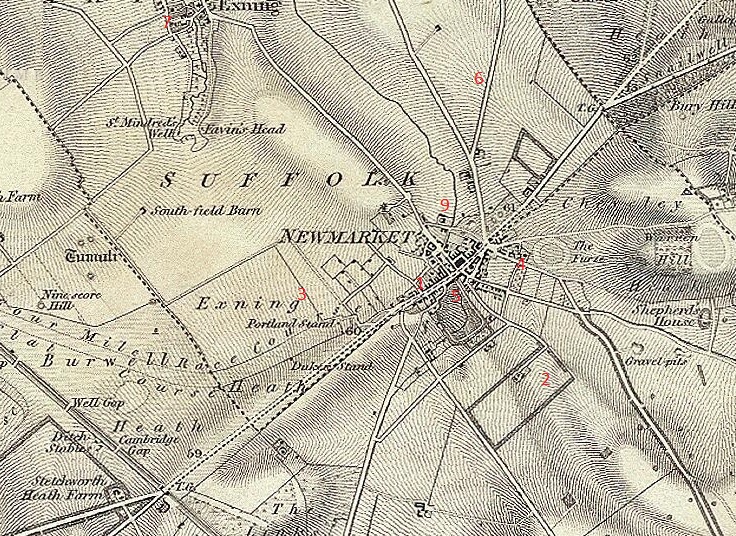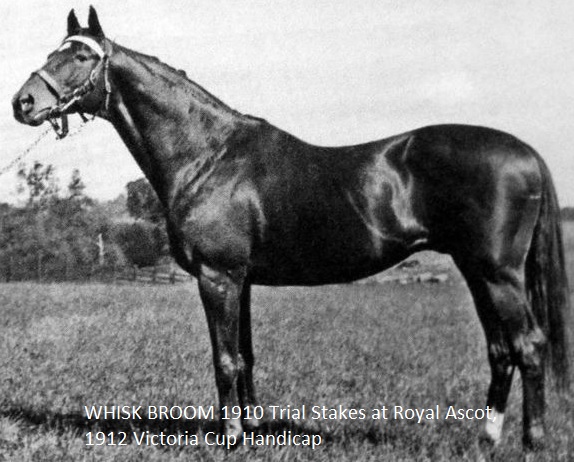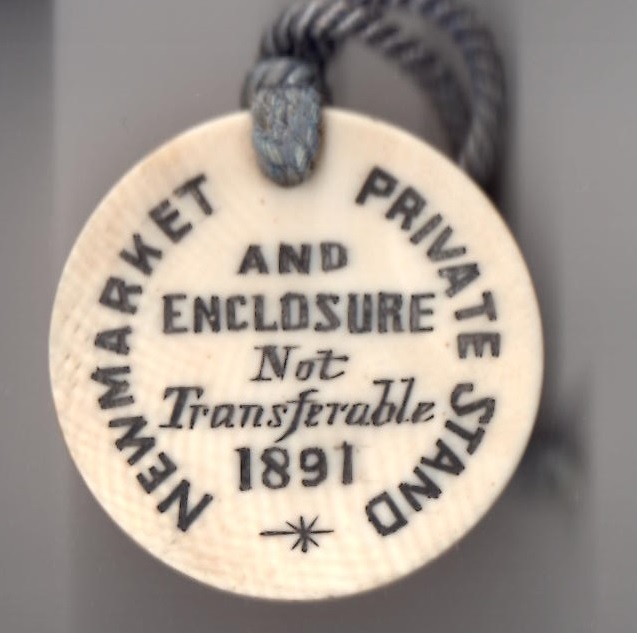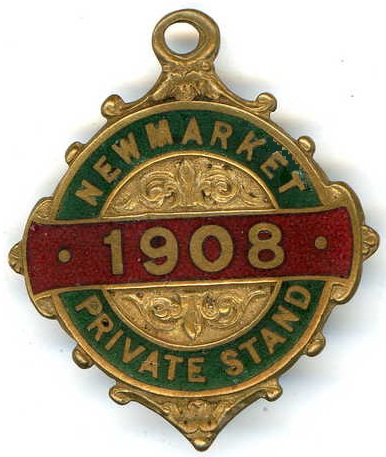1850-1873 Thomas Dundas, Marquess of Zetland
Thomas Dundas, born in Marylebone on 5th February 1795, was the eldest son of Lawrence Dundas, 1st Earl of Zetland, and his wife Harriet Hale. He was educated at Harrow, followed by Trinity College, Cambridge, and was then elected as a Whig MP in 1818. In 1839 he became the 2nd Earl of Zetland on the death of his father. Dundas was a keen supporter of the turf and was a senior member of the Jockey Club, winning the 1850 Epsom Derby, St Leger and Doncaster Cup with the great Voltigeur. He formed an integral part of the 'Race of the Century' on the Knavesmire in May 1851 when Voltigeur was beaten by The Flying Dutchman, despite having beaten The Flying Dutchman by half a length in the previous year's Doncaster Cup. He later went on to win a third classic, the 1857 2000 Guineas with Vedette and, in the same year, won the Ascot Gold Cup with Skirmisher. He died at Aske Hall, Yorkshire on 6th May 1873.
1850 Epsom Derby VOLTIGEUR (SR 2073) 16/1 owned by 2nd Earl of Zetland, trained by Robert Hill and ridden by Job Marson
1850 St Leger VOLTIGEUR (SR 2073) 8/13 fav owned by 2nd Earl of Zetland, trained by Robert Hill and ridden by Job Marson
1850 Doncaster Cup VOLTIGEUR 4/1 owned by 2nd Earl of Zetland, trained by Robert Hill and ridden by Nat Flatman
1857 2000 Guineas VEDETTE (SR 1963) 5/2 owned by 2nd Earl of Zetland, trained by George Abdale and ridden by John Osborne junior
1857 Ascot Gold Cup SKIRMISHER 4/1 owned by 2nd Earl of Zetland, trained by George Abdale and ridden by Johnny Charlton
1873-99 Lawrence Dundas, 1st Marquess of Zetland
Lawrence Dundas, born in London on 16th August 1844, was the son of John Charles Dundas, younger son of Lawrence Dundas, 1st Earl of Zetland, and Margaret Matilda. He was educated at Harrow School, followed by Trinity College, Cambridge, and was then commissioned in the Royal Horse Guards. He became 3rd Earl of Zetland on 6th May 1873 on the death of Thomas Dundas, later preferring the title of 1st Marquess of Zetland. In 1871 he married Lady Lilian Selina Elizabeth Lumley, daughter of Richard Lumley, 9th Earl of Scarborough, and they had 5 children, Hilda, Thomas, Lawrence, Maud and George. He was a good friend of James Lowther and they both had horses, though never in partnership, trained by Joseph Enoch at Zetland Lodge Stables. Joseph Enoch, Lord Zetland's trainer, whose racing colours were white with red spots and red cap, were easily identifiable in the winners enclosure. Enoch had a privileged education in how to train racehorses having previously been Head Lad with John Day at Danebury. One of Lord Zetland's best horses was Prism who won the Stockton Stewards Cup in 1884 when partnered by John Watts. He died at Aske Hall, Yorkshire on 11th March 1929 aged 84.
1884 Stockton Stewards Cup PRISM 4/5 fav owned by Lord Zetland, trained by Joseph Enoch and ridden by John Watts
1873-92 James Lowther, Joseph Enoch
James Lowther, born on 1st December 1840, was educated at Westminster School and Trinity College, Cambridge, graduating with a BA in 1862, and an MA in 1866, He was then called to the Bar, and also became an MP. At Trinity he was a contemporary of Hon. Henry Fitzwilliam, and they reconstituted the Swinton Club, later organising race meetings on Fitzwilliam's personal racecourse. In his Cambridge days Lowther patronised Royston and Old Valley racecourses, and seldom missed a Newmarket meeting. In later life he, along with his good friend the Earl of Zetland, were stewards at the East Riding Club and Racecourse. In 1873 he registered his racing colours, blue and yellow hoops with red cap, and he and the Earl of Zetland stabled their horses at Zetland Lodge Stables where they installed Joseph Enoch as their trainer. James Lowther had a deep affinity with the Knavesmire; his kinsman Lord Lonsdale owned a bay horse called Monkey which had won one of the earliest recognised races at York, His Majesty's One Hundred Guineas Plate over 4 miles in 1731. A later Lord Lonsdale (Viscount Lonsdale) won the 1831 Epsom Derby with Spaniel (SR 1998). In 1874 James Lowther won the Tankersley Park Plate with Sir Robert Walpole ridden by his friend Charles Fitzwilliam. He enjoyed an even greater, and more pleasurable, success in the 1877 Gimcrack Stakes with King Olaf ridden by Fred Archer, but, as a consequence, he had to present 4 dozen bottles of champagne at the York Gimcrack dinner. Arguably his best horse was King Monmouth who won the 1885 Great Yorkshire Stakes at York and, a month later, the Great Yorkshire Handicap at Doncaster. The horse returned to York 4 years later to land the Ebor Handicap. James continued to enjoy his racing, particularly at Newmarket, until his death on Monday 12th September 1904.
1874 Tankersely Park Plate at Earl Fitzwilliam's private racecourse SIR ROBERT WALPOLE, owned by James Lowther, trained by Joseph Enoch and ridden by Hon Charles Fitzwilliam
1877 Gimcrack Stakes KING OLAF 4/5 fav owned by James Lowther, trained by Joseph Enoch and ridden by Fred Archer
1879 Eglinton Stakes EMMA filly owned by James Lowther, trained by Joseph Enoch and ridden by Jim Snowden
1885 Great Yorkshire Stakes at York KING MONMOUTH 100/14 owned by James Lowther, trained by Joseph Enoch and ridden by John Watts
1885 Great Yorkshire Handicap at Doncaster KING MONMOUTH 3/1 owned by James Lowther, trained by Joseph Enoch and ridden by Jim Snowden
1888 Zetland Stakes HOUNDADITCH 7/1 owned by James Lowther, trained by Joseph Enoch and ridden by John Watts
1889 Ebor Handicap KING MONMOUTH 5/2 fav owned by James Lowther, trained by Joseph Enoch and ridden by John Watts
1892-1893 Harry Thomas Enoch
Harry Thomas Enoch, born at Letcombe Regis, Oxfordshire in 1866, was the third son of prominent racehorse trainer Joseph Enoch who trained at Zetland Lodge, Newmarket. Joseph, and his wife Catherine, had 7 sons and 2 daughters, namely Albert John (born 1863), Walter E (1865), Harry T (1866), Arthur W (1870), Alfred W (1872), Ernest (1877), Annie C (1867) and Margarita (1875) and they lived at 20 and 21 St Marys Square. After his schooling Harry became a moderately successful jockey and groom, having his first ride at Redcar on Thursday 14th August 1879 aboard Ulysses, but he finished unplaced. He rode his first winner at Newmarket on Monday 25th October 1880 on Griselda. He retired from race riding in 1892, turning his hand to training, taking over the reins at Zetland Lodge from his father Joseph, landing his first winner as a trainer, Flodden Field for Captain E W Baird. He married Evelyn, and was appointed private trainer for Colonel E W Baird and Douglas Baird at Beechwood House stables, Exning, from 1893, recording one of his most high-profile successes in 1899 when Musa won the Epsom Oaks owned by Douglas Baird.
For over 4 centuries racing has been staged in Newmarket, but how have the racecourses evolved from an initial starting point at Fleam Dyke Pumping Station, some 8 miles from the town, with a winning post barely 200 metres from the town centre, into two world recognized, excellent racecourses and a universal acceptance that Newmarket is the Headquarters of racing?
To access an interactive racecourse map showing over 50 individually named racecourses CLICK HERE. The map will enable you to:-
1. Determine when extended races over 8 miles, 6 miles and 4 miles began to be replaced by the courses now visited by thousands annually;
2. Consider how the challenge of crossing the Devil's Dyke was overcome;
3. Contemplate why the town no longer has a steeplechase course despite having at least 5 courses during the past 2 centuries;
4. Examine the practicalities of having up to 48 starting posts and winning posts;
5. Appreciate that it was not financially viable to have an open racecourse spread widely across the heath, with a finishing post barely 200 metres from the town centre;
6. Research how and why the Cambridgeshire Handicap has been contested over 3 different courses.
NOTE: The map does not make mention of 2 particular courses:-
(i) Sefton Course (also known as the Cambridge Road Course)
Source: 1970 Raceform. Used from 1959 to 1975.
(ii) New Circular Course
The Circular Handicap was run on Friday 29th October 1875 on the New Circular Course of about two miles.
Source: London Standard (30th October 1875): ''the horses started near the Turn of the Lands, ran back way of the Cambridgeshire Course towards the Ditch, and afterwards proceeded down the side of the Tan Gallop, and turned into the Rowley Mile near the Bretby Stakes starting post, finishing at the stand at the end of the flat. Except in the hollow near the Cambridgeshire start the runners should have been visible all the way if the sky had been bright and clear''.
Another report hoped that the Circular Handicap would become a feature in future programmes, as it would be contested in front of the new grandstand which would be completed in about a year and would be able to accommodate thousands.
(I am grateful to Tim Cox for bringing attention to these 2 courses.)
Enjoy researching the intriguing history of Newmarket and its many racecourses.

September 1899-1903 Sir John Blundell Maple, Willie Waugh, Dawson Waugh
In September 1899 Sir John Blundell Maple purchased Zetland House and Stables, previously owned by Joseph Enoch, former trainer for Lord Zetland, finding that his Falmouth House Stables were insufficient to accommodate his immense stud. He installed Dawson Waugh as assistant to his brother Willie, who had trained for Sir John since 1897. After the death of Sir John in 1903, William Waugh bought Zetland Lodge, changing its name to Balaton Lodge in honour of the Hungarian lake, the largest lake in central Europe, close to where his father had trained for Prince Festitics. His brother Dawson moved to Somerville Lodge in 1903 to continue training.. Shortly after taking charge at Balaton Lodge Willie was made an offer he could not refuse, taking on Kingsclere Stables.
1903-1905 Willie Waugh
Willie Waugh had enjoyed a spell as private trainer to Sir John Blundell Maple at Falmouth House, but on the death of Sir John in 1903 he purchased Zetland House, which he renamed Balaton Lodge after Lake Balaton in Hungary. William hired Mr Bird as his manager in the early days with Sir John, and Sam Loates and the ill-fated Willie Lane as stable jockeys. In 1900 his brother, Dawson Waugh, returned from Hungary, where he was private trainer to Prince Festetics, to be assistant to Willie, who was struggling with his health at the time. When Sir John died in 1903 Willie and Dawson went their separate ways, Dawson moving to train at Somerville Lodge.
1905-December 1907 John Edward Brewer
On departing for Kingsclere in 1905 William Waugh leased Balaton Lodge to the Australian trainer John Edward Brewer. John Brewer was born in Australia in 1868, training there at the start of his training career, but moving to England to train at Lewes. He was an accomplished rider, winning the 1891 Caulfield Grand National Steeplechase on Busaco. He then moved from Lewes to Epsom in April 1899 and married Edith Nightingall, sister of William and Arthur Nighingall, on 16th June 1900. When he travelled over from Australia, he brought The Grafter, 1898 Melbourne Cup winner, with him, landing the City and Suburban at Epsom in April 1900. He and his new wife travelled back to Australia on 22nd June 1900. Brewer returned to England in 1905, taking a lease on Balaton Lodge Stables in Newmarket. In December 1907 Mr John Edward Brewer, ably supported by Mr William Clark and Mr Lionel Robinson, moved from Balaton Lodge to taking up a training post at Park Lodge, managing to sublet Balaton Lodge to Mr Keene and Mr Belmont. He had rewarded William Clark by winning the 1907 Cesarewitch with Demure 4/1 when ridden by Frank Wootton. In early 1911 John Brewer developed a significant swelling on his neck which required urgent surgery in Cambridge, but then he and Richard Wootton purchased Kiscatoo Station Stud, on the banks of the Lachlan river in New South Wales. He died of a heart affliction on Tuesday 14th April 1931 at Elsternwick near Melbourne.
When John Brewer departed for Park Lodge in December 1907 he was able to sublet Balaton to Mr Keene and Mr Belmont who remained for just one year.
Andrew Jackson Joyner was born on 4th August 1861 in Enfield, North Carolina. He worked as a jockey for a few years, riding for Hall of Fame trainer William Burch, but then became a trainer in his own right, saddling his first winner in 1884. He was amazingly successful, winning almost all of the top American races, including the 1905 and 1908 Preakness Stakes with Cairngorm and Royal Tourist respectively. Cairngorm was owned by Sydney Paget and ridden by Willie Davis, while Royal Tourist was owned by Harry Payne Whitney and ridden by Eddie Dugan. When, in late 1908, anti-betting laws were introduced in the USA, Andrew (Jack) Joyner transferred his training operation to Newmarket, taking over the racing establishment of Balaton Lodge. He was ably supported by assistant George Frederick Leader, who later trained at Saville House. Although Andrew Joyner was in the American Hall of Fame as a trainer, he was almost as successful in England. Two horses in particular, Borrow and Whisk Broom, both owned by Harry Payne Whitney, were trained by Joyner to win many top-class races in England. Borrow won the 1910 Middle Park Stakes, the Windsor Castle Stakes, and in 1912 the Wokingham Handicap. In 1913 he won the Challenge Stakes and the Ayr Gold Cup. Whisk Broom won the 1910 Trial Stakes at Royal Ascot, and two years later the Victoria Cup Handicap, before transferring to America to win such high-class races as the 1913 Metropolitan, Suburban and Brooklyn Handicaps. Andrew Joyner continued to train successfully in England until returning to America in November 1915.

1910 Middle Park Stakes BORROW owned by Harry Payne Whitney, trained by Andrew Joyner and ridden by J H (Skeets) Martin
1910 Windsor Castle Stakes BORROW owned by Harry Payne Whitney, trained by Andrew Joyner and ridden by J H (Skeets) Martin
1910 Trial Stakes at Royal Ascot WHISK BROOM owned by Harry Payne Whitney, trained by Andrew Joyner and ridden by J H Martin
1910 Hopeful Stakes BORROW owned by Harry Payne Whitney, trained by Andrew Joyner and ridden by J H (Skeets) Martin
1912 Victoria Cup Handicap WHISK BROOM owned by Harry Payne Whitney, trained by Andrew Joyner and ridden by J H Martin
1913 Challenge Stakes BORROW owned by Harry Payne Whitney, trained by Andrew Joyner and ridden by Skeets Martin
1913 Ayr Gold Cup BORROW (7/2 jt fav) owned by Harry Payne Whitney, trained by Andrew Joyner and ridden by J H (Skeets) Martin
1916-November 1919 Stables empty
Despite his best effort to lease Balaton Stables during the war years, they remained empty until Willie Waugh returned from Kingsclere. In October 1916 Bob Colling, a North Yorkshire trainer, had tried to negotiate a lease without success, while in February 1917 Balaton Lodge was one of many Newmarket Stables, including Green Lodge, Ellesmere House and Melton House, which remained empty.


December 1919-27 Willie Waugh
After many successful years training at Kingsclere, Willie Waugh returned to his Balaton Lodge Stables at the start of December 1919 to resume his training career at Headquarters. He had leased his stables to Australian trainer John Brewer and American trainer Andrew Joyner, and had tried unsuccessfully to lease out the stables during the war years. Although he did not enjoy the same success he had at Kingsclere, he did win the 1923 Cambridgeshire and 1924 Coronation Cup with Verdict owned by the 9th Earl of Coventry. Willie suffered poor health for a while, and when he was taken ill at a Trent Bridge test match in the summer of 1926 many thought his time was up, but Willie struggled through, but died on Friday 11th February 1927.
1923 Cambridgeshire VERDICT 100/7 owned by 9th Earl of Coventry, trained by Willie Waugh and ridden by Michael Beary
1924 Coronation Cup VERDICT 3/1 owned by 9th Earl of Coventry, trained by Willie Waugh and ridden by Steve Donoghue
1927-1942 Lady Gladys Yule, James 'Boxer' Cannon
Annie Henrietta Yule, born in 1874, was the only daughter of Andrew Yule and his wife Emma Porter; a wealthy family. Her father founded the Yule conglomerate which is now owned by the Indian Government. She married her cousin Sir David Yule and they had one daughter in 1903 named Gladys. Although their business interests were based in India, Lady Yule refused to remain in India, returning to England with her daughter. Lady Yule financed films and also bred Arabian horses, and when Willie Waugh died in February 1927 Lady Yule purchased Balaton Lodge and stables. She was able to set up a breeding establishment, and when her husband David died the next year, she and her daughter became the wealthiest women in England. They continued to breed Arabian horses at their Hanstead Stud, as well as maintaining her thoroughbred stables at Balaton Lodge. In December 1932 she appointed James Herbert Sharp 'Boxer' Cannon as her trainer, a post he held until 1937. During his time at Balaton Lodge his most successful horse was Within the Law who won the 1934 Yorkshire Cup. The Animal Health Trust was founded by Dr Walter Reginald Wooldridge in Newmarket in 1942, and when Lady Yule handed over her Balaton Lodge facilities in 1946, Dr Wooldridge moved into Balaton Lodge.
1934 Yorkshire Cup at York WITHIN THE LAW 10/1 owned by Lady Gladys Yule, trained by James Cannon and ridden by W Wells
1942-1998 Animal Health Trust and Equine Research Station
Lady Yule died on 25th July 1950, but the pioneering work continued at the site which she had bequeathed, working hand in hand with the Equine Research Station. In 1993 the Research Station reassembled the skeleton of the famous thoroughbred Hyperion, and the horse now stands on display at the National Horse Racing Museum in Newmarket. The Animal Health Trust continued to operate at Balaton Lodge until 1998.
1999-present
Balaton Lodge, courtyard and stables have now been turned into private dwellings.
BORROW (1910 Middle Park Stakes, Windsor Castle Stakes)
VERDICT (1923 Cambridgeshire, 1924 Coronation Cup)
KING MONMOUTH (1885 Great Yorkshire Stakes & Handicap, 1889 Ebor Handicap)
WHISK BROOM (1910 Trial Stakes, 1912 Victoria Handicap)
KING OLAF (1877 Gimcrack Stakes)



